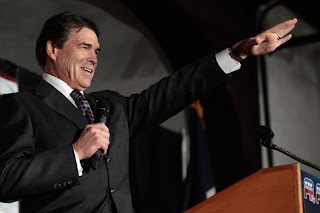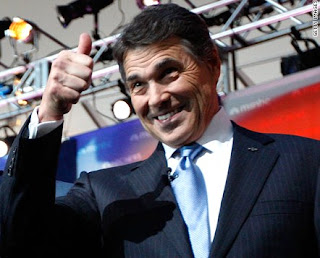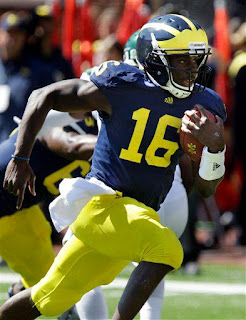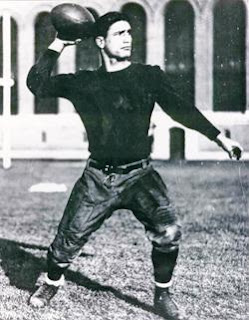 For better or for worse, I live in Rick Perry’s Texas; in the Dallas suburb of Plano, which very much resembles everything that is right AND wrong with his stewardship of the Lone Star State.
For better or for worse, I live in Rick Perry’s Texas; in the Dallas suburb of Plano, which very much resembles everything that is right AND wrong with his stewardship of the Lone Star State.And while the national media scrambles around the state, looking for golden nuggets of information (like miners in the late 1840s in the California mountains), all they have to do is ask me and I’ll deliver (as it said down here) “the straight skinny” on the person often referred as “Gov. Goodhair.”
My section of suburbia has been the recipient of great expansion from prior decades, but now property values are falling, foreclosures and homelessness are increasing, college is less affordable, diversion of tax dollars from intended causes to the general revenue stream means less for road and state park repairs (going against voters’ wishes) and more children than ever are having children – the most in the United States.
The state unemployment rate is rising slowly but steadily and this month, Texas LOST jobs because the sector of highest previous growth (public sector/government) is bleeding more workers than private business can create. Texas is not what you, or Gov. Perry, think.
First, a little background: Rick Perry has been a fixture of Texas politics since 1986 (meaning he’s been on the state payroll) from state representative to agriculture commissioner to lieutenant governor. He’s been the state’s longest serving governor, elected three times on his own after assuming the office following George W. Bush’s ascendance to the Presidency.
Originally a conservative Democrat from the flat, dusty West Texas county of Haskell, Perry switched parties in 1989 and ran for the ag commissioner slot, pulling a stunning upset (at the time) over incumbent populist Democrat Jim Hightower (the year Democrat Ann Richards was elected governor, and the last time Democrats won any statewide contest).
In his second re-election campaign, Perry could only muster 40 percent to win a three-way race against a Houston congressman that few inside that city even knew, and a well-known humorist/musician/prankster named Kinky Freidman. It was NOT Perry’s finest hour; he appeared weak within his own party and in the halls of Austin.
However, he turned the frowns around less than two years ago with his old-fashioned Lone Star “whuppin’” of U.S. Senator Kay Bailey Hutchison for the GOP gubernatorial nomination. Perry’s dynamite was his ferocious attack on all things Washington, D.C., which included Mrs. Hutchison (a fellow Republican, mind you). He also previewed his “Texas is open for business” campaign mantra, completely with pearly whites smiling broadly (not unlike the caricature of any used-car salesman).
His views have NOT really changed since he entered politics … he’s been a hard-ass since Day One. Perry is a graduate of Texas A&M University, where he was no better than a B-minus/C-student, but WAS a Yell Leader (a unique position of control at a unique campus atmosphere) and served in the U.S. Air Force as a pilot. When asked about the differences between himself and Bush, Perry’s standard and truthful retort is “I went to A&M; he went to Yale.” It discloses plenty about the attitudes and, at times, disdain each has for one another. In the 2010 election, ALL of Bush’s inside people and advisors were on Hutchison’s endorsement list and his victory was all the sweeter for that fact.
All during Perry’s 2010 run for governor, he denied at every turn (and microphone) any run for the land’s highest office (which is NOT governor of Texas). Despite all those denials, Perry paved the way for his presidential run with last year’s publication of “Fed Up!,” laying out his attack against all things federal and sounding like any “states rights” governor from the pre-Civil Wars days.
Conservatives lapped it up like a thirsty kitten at a bowl of milk, when he penned such statements as calling Social Security “a crumbling monument to the failure of the New Deal.” Perry insinuated its creation violated the Constitution, said it is a “bad disease” that still is spreading and would prefer “a retirement system that is no longer set up like an illegal Ponzi scheme,’ seeking a system that “will allow individuals to own and control their own retirement.”
But his written words are being questioned and Perry’s campaign is moon-walking away from those statements … plus many, many others. Communications director Ray Sullivan, said he had “never heard” Perry saying Social Security was unconstitutional. And the book does not now … “reflect the governor’s current views.”
Of course, it hasn’t been a year since it hit the bookstands and Perry has constantly usurped what his campaign people are trying to cover by refusing to back down (in public) from such “gunslinger” statements. It demonstrates more of the man’s arrogance than judgment.
Almost everything the press has unearthed about Perry’s record is truthful. Texas DOES lead the nation in jobs created because … 1) the state’s population growth has been the largest, 2) the oil and natural gas business is in its cyclical upswing (we’ve also had two industry-crashing busts in my 36-plus years as a resident), 3) it is a right-to-work state where unions, except for those civil service communities that permit police and fire personnel to collectively bargain, have no power whatsoever, and 4) there is no state income tax (revenues come either from consumption sales or ad valorem, or property, taxation.
However, ask ANY Texan, and they will ALL complain about taxes being too high. Ask any school district superintendent, and they will ALL tell you it’s an inadequate system to properly fund education. Which is why another truth about Perry had him approving a $3-4 BILLION cutback to public education, resulting in tens of thousands of layoffs among the 2,500 Texas school districts.
Texas is also tops in the country is the numbers of minimum wage jobs, lead in the number of children living in poverty, number of high school dropouts, largest percentage of adults without health insurance and number of prison beds. And there are the little things where Texas is number one (root, root, for the home team?) – first for heavy equipment thefts (loaders, backhoes, tractors and forklifts).
The education record is particularly worrisome. In the Perry years, a majority of Texas high school graduates who took the ACT this past year could not pass introductory college courses in math, reading and science. Class sizes are increasing at all grade levels because of the budget reductions, test scores have declined as has classroom staffing on the elementary level. That dropout rate is on the rise, and getting worse by the minute. The facts show how race or ethnic background has little to do with that increase – it’s across-the-board.
Many of the state’s problems – from inability to fund a drastically needed increase in surface water storage capacity to simply fixing the state’s crumbling roads and bridges – has been money. To be precise, the will to allocate funds without either raising revenues/taxes or using the monies actually available, known as the Texas Rainy Day Fund, where a multi-billion surplus sits untouched.
Perry’s opposition to using those funds is rock-rigid and all attempts, including bi-partisan agreements, to dip into that pool have been rebuffed. Yet thousands are unemployed because it won’t be used to meet the state’s obligations to fund public education (the legislature and governor simply rewrote the rules to suit their immediate financial needs).
Sadly, the national media, and other candidates, have been as slow as Vermont molasses in February, to research Perry and other past actions, especially as governor, in the area of political cronyism.
The entire HPV vaccine/Gardacil situation, which has garnered a ton of national attention, is (correctly) more about the cronyism all-too-often seen circling Perry and associates; the debate about whether the vaccine should be employed is a parallel discussion. What rankled many in Texas was his end-around the legislature through executive order and who, in the end, was the big financial benefactors.
There is SO much more to dig through, not much different than looking for clues in the middle of a massive garbage dump – there’s tons of it and it all stinks!
For example, Perry controls (without any transparency) a huge “technology fund” which doles out grants and big dollars at the sole discretion of the officeholder. One such situation involved (now-defunct and horribly bankrupt) Countrywide Mortgage, which got millions from that source in return for thousands of jobs. Not only did the whole plan fall through, Countrywide was subject to criminal investigation.
Perry tried to use eminent domain to confiscate tens of thousands of Texas ranch/farm land and then turn it over to private Spanish (Cintra) developers for a system of super-highway toll roads, called the Trans-Texas Corridor. It would have covered 4,000 miles, in all directions, and it would have been operated, and controlled, by that foreign-based entity. Shockingly, Perry was taken aback by the tremendous adverse reaction and the project was killed … by the Texas Legislature, not the governor. Everything about Perry can be seen through the eyes of cronyism. The rift between Perry and former President George W. Bush stems from Bush’s failure in 1995, as a new governor, to appoint Perry’s brother-in-law to an open seat on the 11th Court of Appeals. Bush said he’d choose someone of his own liking and Perry got steamed.
There’s SO much to say about Perry and his oft-avoidance of the truth. Despite what he told a young elementary-aged student at a political event, Texas does NOT teach creationism in public school, although he wants it to be included. It’s just one of many such examples.
It is difficult to see how someone who cannot stand so many parts of the U.S. Constitution and wants to alter it so drastically would want to be its defender and protector. He doesn’t want you, the average citizen, to vote on how operates in the U.S. Senate (17th Amendment), eliminate one of the basic checks and balances within the federal government by abolition of the lifetime terms for federal judges (Article III, Section I), outlaw the federal income tax (16th Amendment), given Congress veto power over Supreme Court decisions by 2/3rds vote (court suppression which is totally against principles established by the dear “Founding Fathers”), and adding amendments to ban same sex marriage (now being done as a 10th Amendment state’s rights issue) and mandatory balanced budget amendment (in a document which never mentions ANY form of economic policy to be employed).
Again, the anti-judicial stance is really disturbing. How does Perry expect to take the oath of office from someone whose responsibilities he disdains?
I could argue all these base points for weeks – to prevent Rick Perry from being elected president, but I can sum up most of my reasons in this anecdote.
One of the most visible changes in the American (and Texan) workforce can be seen at some of our lowest level jobs on the career ladder. Faces that occupy such jobs as drive-through tellers at the increasing number of fast food outlets, cashiers at lots more new pharmacies (that sells almost everything else but drugs) and in the checkout line of the supersizing grocery stores are no longer perky high school young adults. Those entry-level jobs, which used in the past to teach people of that age group the value of hard work, savings and reward, are now filled by middle-aged adult men.
The mere sight of men my age doing what MUST be demeaning work borne out of drastic economic necessity is sad. These people probably have more (college) degrees than any thermometer and could best served society is ways other than asking if I want ketchup with my fries.
 So here I was, last Sunday, at the grocery store (name withhold for protection of its own reputation, although I don’t know why), with my weekly purchases and there was a man, well into his 80s, bagging the items, slinging around the bags into the cart and helping my wife to our vehicle.
So here I was, last Sunday, at the grocery store (name withhold for protection of its own reputation, although I don’t know why), with my weekly purchases and there was a man, well into his 80s, bagging the items, slinging around the bags into the cart and helping my wife to our vehicle.His arms showed ulcerations from prior wounds and he walked in a slight stoop, but he was on the job … and all I could ask myself was, “Why?”
Was it that bad, was his Social Security/Ponzi scheme payout so inadequate that he was forced to bag up pork chops, Cheerios and Hamburger Helper just to make his ends meet? Is THIS what our country is coming to?
The problem is that the old man was NOT an anomaly; in Rick Perry’s Texas, it’s become all too commonplace. And it’s not how the United States should be. If Perry becomes president, it could well be.







